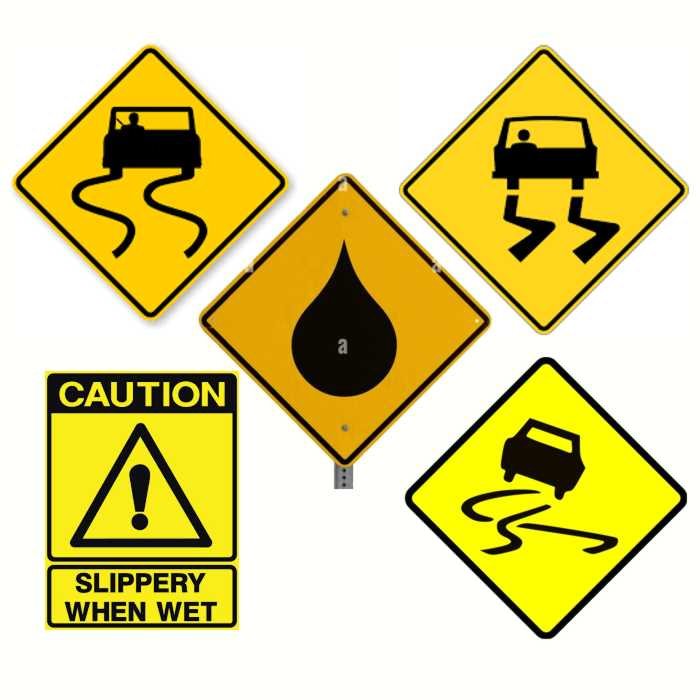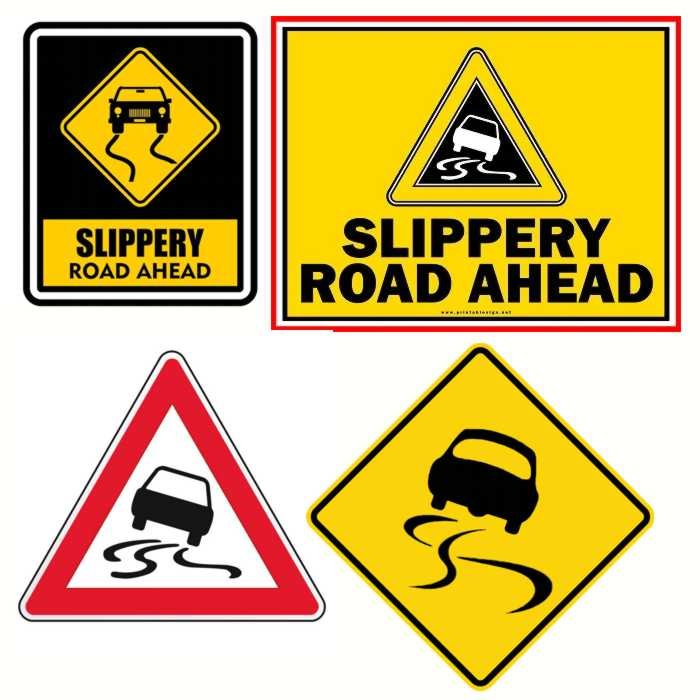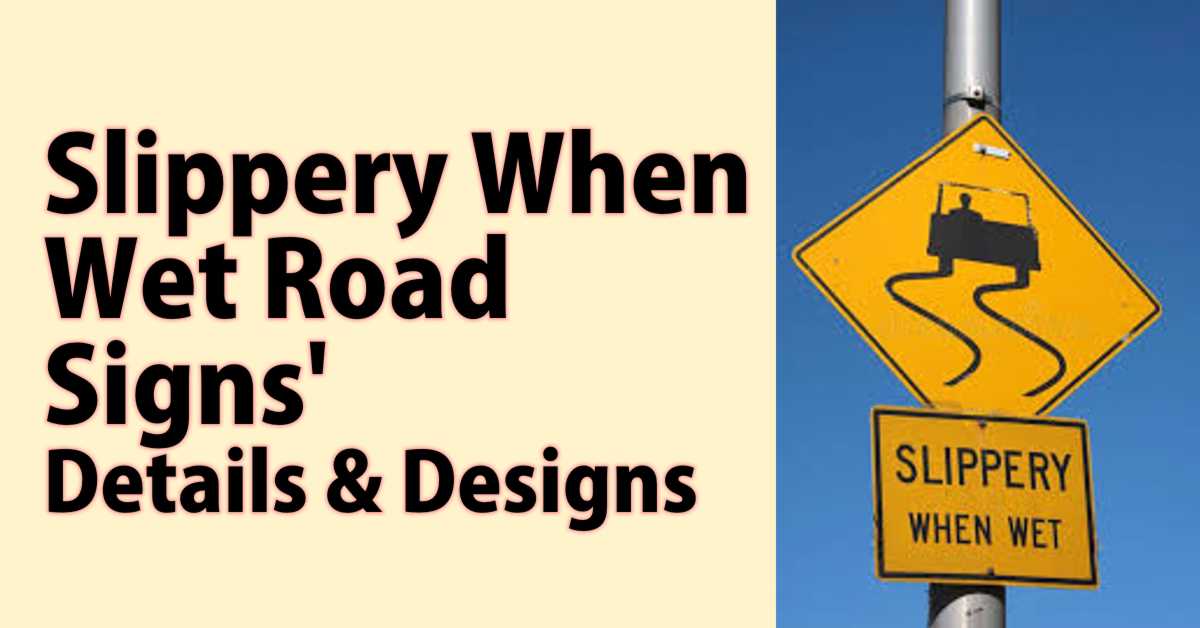As a licensed civil engineer and construction specialist with over 25 years of experience in asphalt materials, specifications, and roadway construction, I understand the critical importance of proper road signage in ensuring the safety of motorists and pedestrians alike. Among the various types of road signs, the “Slippery When Wet” sign holds a special significance, as it is crucial in alerting drivers to potentially hazardous conditions and preventing accidents.
Understanding Caution Slippery When Wet Sign
Wet road surfaces can become extremely slippery, especially when combined with oil residue, loose gravel, or weather conditions like rain or snow. This slippery condition can significantly reduce tire traction, increasing the risk of skidding, loss of control, and potential accidents.
As an experienced civil engineer, I’ve witnessed firsthand the consequences of inadequate warning systems for slippery road conditions. That’s why I strongly advocate for the proper use and placement of “Slippery When Wet” signs to mitigate these risks.
Design and Placement Considerations
The effectiveness of “Slippery When Wet” signs relies heavily on their design and strategic placement. These signs must adhere to specific guidelines and regulations to ensure maximum visibility and clarity for drivers. Key considerations include:
Sign Size and Reflectivity:
Larger signs with highly reflective materials are essential for optimal visibility, especially in low-light conditions or inclement weather.
Placement and Positioning:
Signs should be placed in advance of potential slippery areas, allowing drivers sufficient time to adjust their speed and driving behavior.
Supplementary Signage:
In some cases, additional signage may be required to reinforce the warning, such as advisory speed limits or curve warnings.
Popular Slippery When Wet Road Sign
Warning Sign
A diamond-shaped sign with a depiction of a slippery surface and the words “Slippery When Wet” written underneath.
Wet Road Ahead
A rectangular sign indicating the presence of a wet road ahead, often accompanied by the words “Slippery When Wet.
Skidding Car Symbol
A triangular caution sign with a pictogram of a skidding car, indicating slippery conditions.
Water Droplets Symbol
Some signs feature a symbol of water droplets to indicate wet road conditions, along with a warning message.

What Does Slippery When Wet Sign Mean
The “Slippery When Wet” road sign is a warning sign that alerts drivers to potentially hazardous conditions on the roadway when it is wet or raining. Here are some detailed driving insights regarding this sign:
Surface Hazard
When a road surface becomes wet, it can become slippery, reducing the tire traction and increasing the risk of skidding or losing control of the vehicle. This is especially true on surfaces like polished concrete, steel bridges, and freshly applied road markings.
Reduced Braking Distance
Wet roads significantly reduce a vehicle’s braking ability. The thin layer of water on the road surface can cause tires to hydroplane or lose contact with the pavement, leading to an increased stopping distance. Always increase your following distance and brake gently when driving on wet roads.
Reduced Visibility
Heavy rain can impair visibility, making it harder to see lane markings, other vehicles, pedestrians, and potential hazards on the road. Reduce your speed and use windshield wipers and defrosters to improve visibility.
Standing Water
In my opinion, During heavy rain or flooding, water can accumulate on the road surface, creating a risk of hydroplaning, where the vehicle’s tires lose contact with the pavement and cause a loss of control. Avoid driving through deep-standing water if possible.
Curve Caution:
Wet roads are particularly hazardous when navigating curves or ramps. The reduced traction can cause a vehicle to slide or lose control more easily. Slow down and avoid sudden steering or braking movements when approaching curves or ramps.
Weather Conditions:
The “Slippery When Wet” sign may be supplemented by additional information about the weather conditions, such as “When Raining” or “During Ice/Frost” to provide more specific warnings.
Driver Preparedness:
When you see the “Slippery When Wet” sign, it is essential to adjust your driving behavior accordingly. Reduce your vehicle’s speed, increase following distances, avoid sudden maneuvers, and be prepared for reduced traction and visibility.
In developing this article, I have consulted with various authoritative sources and governing bodies to ensure the accuracy and compliance of the information provided. These sources include:
- The Federal Highway Administration (FHWA), sets national standards for road signage and traffic control devices through the Manual on Uniform Traffic Control Devices (MUTCD). Chapter 2C. Warning Signs And Object Markers
- State and local transportation agencies may have additional guidelines and regulations specific to their jurisdictions.
- Industry organizations, such as the American Traffic Safety Services Association (ATSSA), provide best practices and guidance for traffic safety professionals.
By leveraging these authoritative sources, I aim to provide reliable and up-to-date information on the proper use and implementation of “Slippery When Wet” road signs.
Road Ahead May Be Slippery Sign
The “Road Ahead May Be Slippery” sign and the “Slippery When Wet” sign are both warning signs used to alert drivers of potentially hazardous conditions on the roadway, but they differ in their specific meanings and implications. Here are detailed driving insights for the “Road Ahead May Be Slippery” sign, along with a comparison table highlighting the differences between the two signs.
Driving Insights for “Road Ahead May Be Slippery” Sign:
Potential Hazard:
This sign warns drivers that the road surface ahead may be slippery due to various factors such as weather conditions, spills, or road debris.
Anticipation:
The sign prompts drivers to anticipate and be prepared for potential slippery conditions further down the road, allowing them to adjust their driving behavior accordingly.
Variable Conditions:
The slippery conditions may be localized or intermittent, depending on the road surface, weather changes, or other factors.
Surface Types:
The sign may indicate slippery conditions on specific surface types, such as bridges, overpasses, or shaded areas that are prone to icing or moisture buildup.
Caution Required:
Drivers should exercise extra caution, reduce speed, and be ready to take appropriate action if they encounter slippery conditions ahead.

Comparison Table: “Road Ahead May Be Slippery” vs. “Slippery When Wet”
| Characteristic | “Road Ahead May Be Slippery” | “Slippery When Wet” |
|---|---|---|
| Meaning | Warns of potential slippery conditions ahead | Warns of slippery conditions when the road is wet |
| Condition | May or may not be present currently | Directly related to wet road conditions |
| Timing | Anticipates future slippery conditions | Indicates immediate slippery conditions |
| Certainty | Less certain about the presence or extent of slippery conditions | More certain about slippery conditions when wet |
| Implication | Drivers should be prepared for possible slippery conditions | Drivers should adjust for slippery conditions when the road is wet |
| Duration | Temporary or intermittent slippery conditions | Slippery conditions persist while the road is wet |
| Location | Specific sections or areas of the road | Applicable to the entire wet road surface |
In my view, the “Road Ahead May Be Slippery” sign alerts drivers to the possibility of slippery conditions further down the road, requiring anticipation and preparedness. In contrast, the “Slippery When Wet” sign directly indicates that the road surface is slippery when wet, necessitating immediate adjustments to driving behavior.
Trustworthiness & Appearance
Design and Material Specifications
To ensure the trustworthiness of the information provided, I have compiled a comprehensive table outlining the design and material specifications for “Slippery When Wet” road signs:
| Specification | Requirement |
|---|---|
| Sign Size (Minimum) | 30 inches x 30 inches |
| Reflectivity | ASTM Type III or higher retroreflective sheeting |
| Sign Color | Black legend on yellow background |
| Sign Materials | Aluminum or plastic substrate |
| Mounting Height | 5-7 feet above the ground |
| Sign Placement | In advance of potential slippery areas |
This table serves as a reliable reference for contractors, transportation agencies, and anyone involved in the installation and maintenance of “Slippery When Wet” road signs, ensuring compliance with industry standards and best practices.
Safety Considerations
In addition to the design and material specifications, it’s crucial to consider safety measures when installing and maintaining these road signs. A dedicated table outlining these safety considerations is provided below:
| Safety Measure | Description |
|---|---|
| Traffic Control | Implement proper traffic control measures during installation or maintenance |
| Worker Safety | Ensure workers wear appropriate personal protective equipment (PPE) |
| Sign Visibility | Regularly inspect and maintain signs for optimal visibility and legibility |
| Hazard Mitigation | Address any potential hazards or obstructions near the sign location |
By adhering to these safety considerations, we can ensure the well-being of workers and the public while promoting the effective use of “Slippery When Wet” road signs.
In the ever-evolving landscape of road safety, the proper implementation of “Slippery When Wet” road signs plays a crucial role in preventing accidents and ensuring the smooth flow of traffic. By following the guidelines and best practices outlined in this article, we can collectively contribute to a safer driving experience for all motorists.
Remember, the effectiveness of these signs relies not only on their design and placement but also on the vigilance and awareness of drivers. It is our shared responsibility to heed these warnings and adjust our driving behavior accordingly, especially during adverse weather conditions.
Key Takeaways
As a licensed civil engineer and construction specialist with extensive experience in asphalt materials and roadway construction, I cannot stress enough the importance of proper road signage, particularly when it comes to “Slippery When Wet” warnings. By adhering to industry standards, consulting authoritative sources, and prioritizing safety, we can create a more secure and efficient transportation system for all.
My passion for excellence and commitment to public safety has driven me to continuously seek out innovative solutions and advocate for the proper use of road signage, including “Slippery When Wet” warnings. I am dedicated to sharing my knowledge and experiences to empower others in creating safer and more efficient transportation systems.
Enquiries
Is Polished Concrete Slippery When Wet?
As an experienced contractor specializing in concrete surfaces, I can confidently say that polished concrete can indeed become slippery when wet. The smooth, glossy finish of polished concrete reduces surface friction, making it more prone to becoming slippery in the presence of water or other liquids. To mitigate this risk, I recommend adding a slip-resistant coating or anti-slip treatment to the polished concrete surface, especially in areas with high foot traffic or potential exposure to moisture.
Is Travertine Slippery When Wet?
Travertine, a popular natural stone frequently used in flooring and outdoor applications, can pose a significant slip hazard when wet. The porous and textured surface of travertine tends to become extremely slippery when exposed to water or moisture. To enhance safety, I strongly advise applying a high-quality sealer specifically designed for travertine to improve traction and reduce slipperiness. Additionally, incorporating textured or honed finishes can help increase the surface’s slip resistance.
Is Composite Decking Slippery When Wet?
Composite decking, a popular alternative to traditional wood decking, is generally designed to be slip-resistant, even when wet. The synthetic materials used in composite decking often feature textured or embossed surfaces that provide enhanced traction, reducing the risk of slips and falls. However, it’s essential to keep composite decking clean and free from algae or mildew buildup, which can create slippery conditions. Proper maintenance and cleaning are crucial to maintaining the slip-resistant properties of composite decking.
Is Flagstone Slippery When Wet?
Flagstone, a popular natural stone often used in outdoor applications such as patios and walkways, can become incredibly slippery when wet. The rough and textured surface of flagstone, while providing excellent traction when dry, can become treacherous when exposed to water or moisture. To mitigate this risk, I recommend applying a specialized flagstone sealer with slip-resistant properties. Additionally, incorporating textured or slip-resistant finishes during installation can significantly improve the surface’s traction when wet.
How to Make Concrete Not Slippery When Wet?
To improve the slip resistance of concrete surfaces when wet, I recommend several effective strategies:
- Incorporate a slip-resistant additive or grit into the concrete mix during installation for enhanced traction.
- Apply a specialized anti-slip coating or sealer designed for concrete surfaces, providing a textured and slip-resistant finish.
- Consider stamping or texturing the concrete surface to create a rougher, more slip-resistant texture.
- Install tactile warning strips or non-slip mats in high-traffic areas or areas prone to moisture.
- Implement proper drainage systems and surface grading to prevent water accumulation on the concrete surface.
Is Marble Slippery When Wet?
Marble, a highly polished and smooth natural stone, is notoriously slippery when wet. The glossy and non-porous surface of marble offers minimal traction when exposed to water or moisture, significantly increasing the risk of slips and falls. To enhance safety, I strongly recommend applying a high-quality, slip-resistant sealer specifically formulated for marble surfaces. Additionally, incorporating honed or textured finishes during installation can help improve traction on wet marble floors or surfaces.
Is Slate Slippery When Wet?
Slate, a dense and naturally textured stone, offers good slip resistance when dry. However, when wet, slate can become moderately slippery, especially if the surface is highly polished or lacks proper sealing. To maintain optimal safety, I advise applying a high-quality slate sealer with slip-resistant properties. Additionally, choosing a honed or cleft finish for slate surfaces can further enhance traction and slip resistance when wet.
When should “Slippery When Wet” signs be installed?
“Slippery When Wet” signs should be installed in advance in areas that are prone to becoming slippery when wet, such as bridges, sharp curves, or locations with a history of reduced traction during wet conditions.
Can these signs be used for temporary conditions?
Yes, “Slippery When Wet” signs can also be used for temporary conditions, such as construction zones or areas where spills or debris may create slippery surfaces. In these cases, portable or temporary signage may be employed.
How far in advance should these signs be placed?
The placement distance for “Slippery When Wet” signs should be determined based on the posted speed limit and the specific site conditions. Generally, these signs should be placed far enough in advance to allow drivers sufficient time to adjust their speed and driving behavior.
Are there any maintenance requirements for these signs?
Yes, regular maintenance of “Slippery When Wet” signs is crucial to ensure their effectiveness. This includes inspecting the signs for visibility, legibility, and any damage or obstructions that may impair their function.
Can additional signage be used in conjunction with “Slippery When Wet” signs?
Absolutely. In some cases, supplementary signage such as advisory speed limits, curve warnings, or additional warning beacons may be used in conjunction with “Slippery When Wet” signs to reinforce the message and enhance safety.
Are there any specific guidelines for installing these signs on curves or hills?
Yes, when installing “Slippery When Wet” signs on curves or hills, additional considerations should be taken into account, such as sight distance, sign positioning, and potential obstructions. Consulting with local transportation agencies and following established guidelines is recommended.
Can these signs be customized or modified?
While some customization may be allowed, it is important to follow the guidelines and regulations set forth by governing bodies like the FHWA and local transportation agencies. Any modifications should maintain the integrity and effectiveness of the sign’s message.
Are there any alternative sign designs or messages for slippery conditions?
While “Slippery When Wet” is the most common sign used to warn of slippery road conditions, alternative designs or messages may be used in specific situations or jurisdictions. It is important to consult with local authorities and adhere to established standards.
How often should these signs be replaced?
The frequency of sign replacement depends on various factors, such as the materials used, exposure to weather conditions, and any damage or degradation over time. Regular inspections and a proactive maintenance schedule are recommended to ensure the signs remain in good condition.
